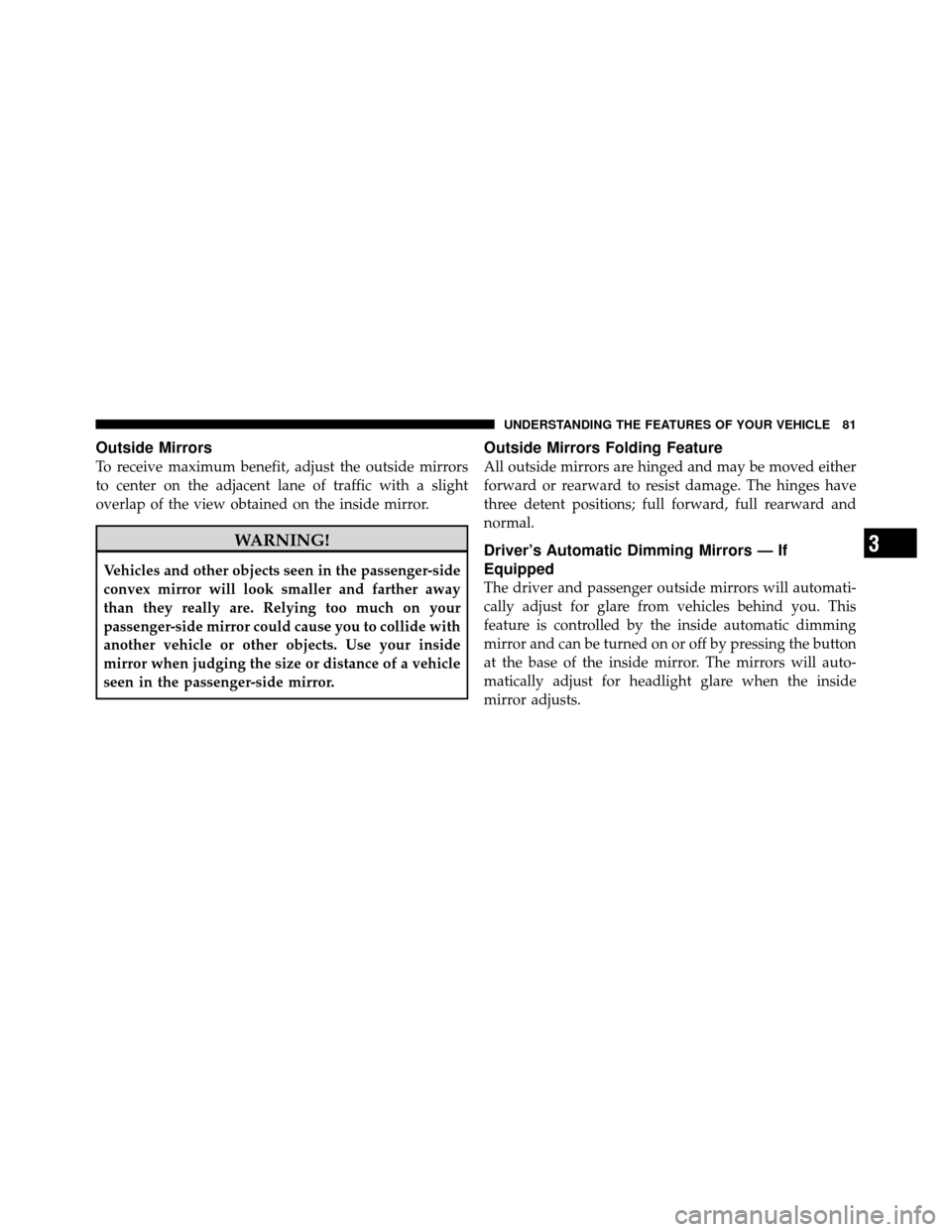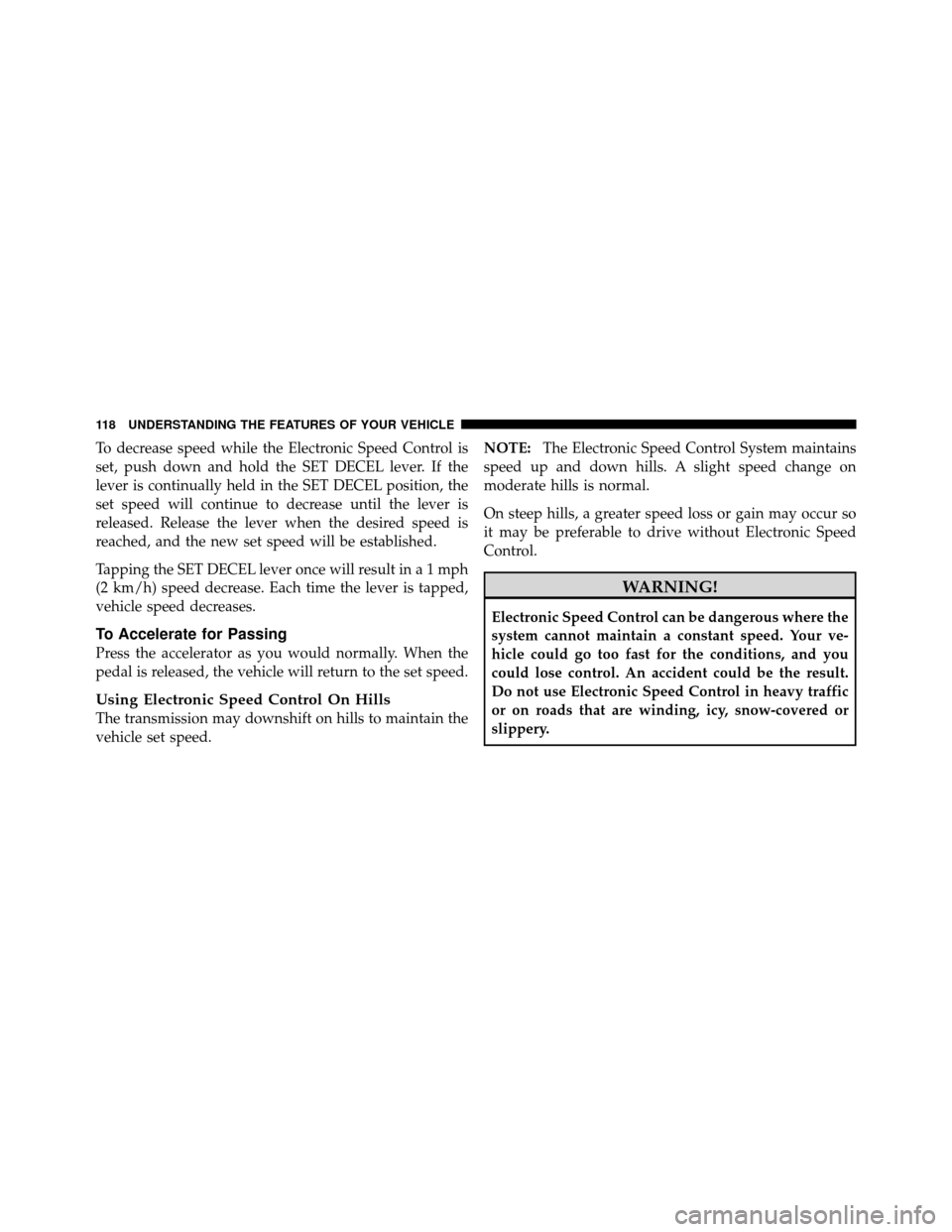Page 61 of 407

3. Requested by police under a legal warrant.
4. Otherwise required by law.
Data parameters that are recorded:
•Diagnostic trouble code(s) and warning light status for
electronically-controlled safety systems, including the
airbag system
•Vehicle speed
•Engine RPM
•Brake switch status
•Pedal position
•And other parameters depending on vehicle
configuration
Child Restraints
Everyone in your vehicle needs to be buckled up all the
time, including babies and children. Every state in the
United States, and all Canadian provinces, require that
small children ride in proper restraint systems. This is the
law, and you can be prosecuted for ignoring it.
Children 12 years and under should ride properly buck-
led up in a rear seat, if available. According to crash
statistics, children are safer when properly restrained in
the rear seats rather than in the front.
There are different sizes and types of restraints for
children from newborn size to the child almost large
enough for an adult safety belt. Always check the child
seat Owner’s Manual to ensure you have the right seat
for your child. Use the restraint that is correct for your
child.
60 THINGS TO KNOW BEFORE STARTING YOUR VEHICLE
Page 74 of 407

Airbag Warning Light
The light should come on and remain on for six to eight
seconds as a bulb check when the ignition switch is first
turned ON. If the light is not lit during starting, see your
authorized dealer. If the light stays on, flickers, or comes
on while driving, have the system checked by an autho-
rized dealer.
Defroster
Check operation by selecting the defrost mode and place
the blower control on high speed. You should be able to
feel the air directed against the windshield. See your
authorized dealer for service if your defroster is
inoperable.
Periodic Safety Checks You Should Make Outside
the Vehicle
Tires
Examine tires for excessive tread wear and uneven wear
patterns. Check for stones, nails, glass, or other objectslodged in the tread. Inspect the tread and sidewall for
cuts and cracks. Check the wheel nuts for tightness.
Check the tires (including spare) for proper pressure.
Lights
Have someone observe the operation of exterior lights
while you work the controls. Check turn signal and high
beam indicator lights on the instrument panel.
Door Latches
Check for positive closing, latching, and locking.
Fluid Leaks
Check area under vehicle after overnight parking for fuel,
engine coolant, oil, or other fluid leaks. Also, if gasoline
fumes are detected or if fuel, power steering fluid, or
brake fluid leaks are suspected, the cause should be
located and corrected immediately.
2
THINGS TO KNOW BEFORE STARTING YOUR VEHICLE 73
Page 78 of 407

▫Lane Change Assist ................... 106
▫ High/Low Beam Switch ............... 106
▫ Flash-To-Pass ....................... 106
▫ Headlight Time Delay ................. 107
▫ Interior Lights ...................... 107
▫ Front Map/Reading Lights ............. 108
� Windshield Wipers And Washers .......... 109
▫ Windshield Wiper Operation ............ 109
▫ Intermittent Wiper System .............. 110
▫ Windshield Washer Operation ............111
▫ Mist ..............................111
▫ Rain Sensing Wipers — If Equipped ....... 112
� Tilt/Telescoping Steering Column .......... 113�
Adjustable Pedals — If Equipped .......... 114
� Electronic Speed Control — If Equipped ..... 116
▫ To Activate ......................... 116
▫ To Set a Desired Speed ................ 117
▫ To Deactivate ....................... 117
▫ To Resume Speed .................... 117
▫ To Vary The Speed Setting .............. 117
▫ To Accelerate For Passing .............. 118
� Parksense� Rear Park Assist — If Equipped . . . 119
▫ Parksense� Sensors................... 119
▫ Parksense� Warning Display ............ 120
▫ Enable/Disable Parksense� ............. 121
▫ Service Parksense� ................... 122
3
UNDERSTANDING THE FEATURES OF YOUR VEHICLE 77
Page 82 of 407

Outside Mirrors
To receive maximum benefit, adjust the outside mirrors
to center on the adjacent lane of traffic with a slight
overlap of the view obtained on the inside mirror.
WARNING!
Vehicles and other objects seen in the passenger-side
convex mirror will look smaller and farther away
than they really are. Relying too much on your
passenger-side mirror could cause you to collide with
another vehicle or other objects. Use your inside
mirror when judging the size or distance of a vehicle
seen in the passenger-side mirror.
Outside Mirrors Folding Feature
All outside mirrors are hinged and may be moved either
forward or rearward to resist damage. The hinges have
three detent positions; full forward, full rearward and
normal.
Driver’s Automatic Dimming Mirrors — If
Equipped
The driver and passenger outside mirrors will automati-
cally adjust for glare from vehicles behind you. This
feature is controlled by the inside automatic dimming
mirror and can be turned on or off by pressing the button
at the base of the inside mirror. The mirrors will auto-
matically adjust for headlight glare when the inside
mirror adjusts.
3
UNDERSTANDING THE FEATURES OF YOUR VEHICLE 81
Page 84 of 407
Illuminated Vanity Mirrors — If Equipped
To access an illuminated vanity mirror, flip down one of
the sun visors.
Lift the cover to reveal the mirror. The light will turn on
automatically.
Uconnect™ Phone — IF EQUIPPED
Refer to “Uconnect™ Phone” in the Uconnect™ User
Manual located on the DVD for further details.
VOICE COMMAND — IF EQUIPPED
Refer to “Voice Command” in the Uconnect™ Phone
User Manual located on the DVD for further details.
SEATS
Seats are a primary part of the Occupant Restraint System
of the vehicle. They need to be used properly for safe
operation of the vehicle.
WARNING!
•DO NOT allow people to ride in any area of your
vehicle that is not equipped with seats and seat
belts. In a collision, people riding in these areas
are more likely to be seriously injured or killed.(Continued)
Lighted Vanity Mirror
3
UNDERSTANDING THE FEATURES OF YOUR VEHICLE 83
Page 89 of 407

WARNING!
Driving a vehicle with the head restraints removed or
improperly adjusted could cause serious injury or
death in the event of a collision. The head restraints
should always be checked prior to operating the
vehicle and never adjusted while the vehicle is in
motion. Always adjust the head restraints when the
vehicle is in PARK.
Front Heated Seats — If Equipped
The front driver and passenger seats are heated. The
controls for each heater are located near the bottom
center of the instrument panel (below the heater/air
conditioning controls). The heaters provide the same
average heat level for both the cushion and the seatback.
After turning the ignition ON, you can choose from High,
Low or Off heat settings. Amber indicator lights in eachswitch indicate the level of heat in use. Two indicator
lights will illuminate for High, one for Low and none for
Off.
Press the switch once to select High-level heat-
ing. Press the switch a second time to select
Low-level heating. Press the switch a third time
to shut the heating elements Off.
When the High-level setting is selected, the heater will
provide a boosted heat level during the first four minutes
of operation. Then, the heat output will drop to the
normal High-level. If the High-level setting is selected,
the system will automatically switch to Low-level after
approximately 30 minutes of continuous operation. At
that time, the number of illuminated LEDs changes from
two to one, indicating the change. The Low-level setting
will turn Off automatically after approximately 30 min-
utes.
88 UNDERSTANDING THE FEATURES OF YOUR VEHICLE
Page 119 of 407

To decrease speed while the Electronic Speed Control is
set, push down and hold the SET DECEL lever. If the
lever is continually held in the SET DECEL position, the
set speed will continue to decrease until the lever is
released. Release the lever when the desired speed is
reached, and the new set speed will be established.
Tapping the SET DECEL lever once will result ina1mph
(2 km/h) speed decrease. Each time the lever is tapped,
vehicle speed decreases.
To Accelerate for Passing
Press the accelerator as you would normally. When the
pedal is released, the vehicle will return to the set speed.
Using Electronic Speed Control On Hills
The transmission may downshift on hills to maintain the
vehicle set speed.NOTE:
The Electronic Speed Control System maintains
speed up and down hills. A slight speed change on
moderate hills is normal.
On steep hills, a greater speed loss or gain may occur so
it may be preferable to drive without Electronic Speed
Control.
WARNING!
Electronic Speed Control can be dangerous where the
system cannot maintain a constant speed. Your ve-
hicle could go too fast for the conditions, and you
could lose control. An accident could be the result.
Do not use Electronic Speed Control in heavy traffic
or on roads that are winding, icy, snow-covered or
slippery.
118 UNDERSTANDING THE FEATURES OF YOUR VEHICLE
Page 157 of 407

INSTRUMENT CLUSTER DESCRIPTIONS
1. Speedometer
Indicates vehicle speed.
2. Brake Warning LightThis light monitors various brake functions,
including brake fluid level and parking brake
application. If the brake light turns on, it may
indicate that the parking brake is applied, that
the brake fluid level is low, or that there is a problem with
the anti-lock brake system reservoir.
If the light remains on when the parking brake has been
disengaged, and the fluid level is at the full mark on the
master cylinder reservoir, it indicates a possible brake
hydraulic system malfunction or that a problem with the
Brake Booster has been detected by the Anti-Lock Brake
System (ABS) / Electronic Stability Program (ESP) sys-
tem. In this case, the light will remain on until the
condition has been corrected. If the problem is related to the brake booster, the ABS pump will run when applying
the brake and a brake pedal pulsation may be felt during
each stop.
The dual brake system provides a reserve braking capac-
ity in the event of a failure to a portion of the hydraulic
system. A leak in either half of the dual brake system is
indicated by the Brake Warning Light, which will turn on
when the brake fluid level in the master cylinder has
dropped below a specified level.
The light will remain on until the cause is corrected.
NOTE:
The light may flash momentarily during sharp
cornering maneuvers, which change fluid level condi-
tions. The vehicle should have service performed, and
the brake fluid level checked.
If brake failure is indicated, immediate repair is neces-
sary.
156 UNDERSTANDING YOUR INSTRUMENT PANEL